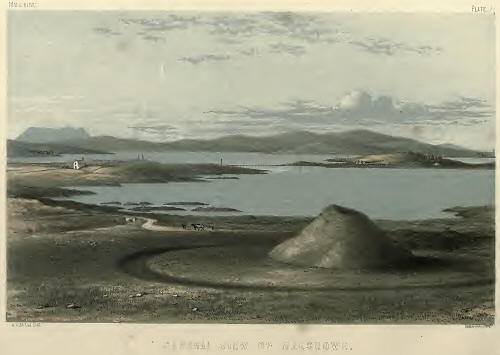|

Arial view of Maes-Howe

Preface
AS the following pages
are intended only for private circulation among friends and
acquaintances, and for presentation to those few Public Societies to
whom such a subject may be interesting, it is hardly necessary to offer
any apology for the many imperfections in the description of Maes-howe,
which may doubtless be pointed out, and for the brief and cursory manner
in which the subject is handled. I desire only to give a plain statement
of facts, in the hope that attention may be drawn to this interesting
discovery, and possibly some further impetus given to the elucidation of
Runic literature. I have received from the learned professors, whose
translations are given, much valuable information, of which, however, I
can only partially avail myself, in consequence of my very imperfect
acquaintance with Runology.
I may add, that every
possible care has been taken to ensure accuracy in the drawings. These
and the ground plans were made by Mr. Gibb of Aberdeen—of whose care and
accuracy in the drawings of ancient monuments Mr. Stuart has spoken so
strongly in his "Sculptured Stones of Scotland," printed for the
Spalding Club. The Runes were mostly drawn by my friend Mr. George
Petrie of Kirkwall, and the drawings afterwards compared by Mr. Gibb
with the originals in the building of Maes-Howe. Two separate sets of
casts were made for me by Mr. Henry Laing of Edinburgh (one of which is
now in the National Museum of the Antiquaries of Scotland, Edinburgh,
and the other in the Museum of the Royal Northern Society of Antiquaries
at Copenhagen.) Nothing could exceed the pains taken by Mr. Petrie and
Mr. Gibb; and the drawings made by Mr. Gibb were on two occasions
collated by him with the casts in Edinburgh, so that I have every reason
to believe that they are as perfect representations of the original
writings on the walls of Maes-Howe as can be hoped for, and not the less
so that the gentlemen who made the drawings and collations were
unacquainted with Runes. I have confined myself to the interpretations
furnished by the three eminent northern antiquaries who have undertaken
the task of deciphering these rude inscriptions, feeling assured that
the high reputation which they enjoy is a sufficient guarantee for the
accuracy of their translations. In concluding these few remarks I am
anxious to bear testimony to the valuable assistance I have received
from my friend Mr. John Stuart, Secretary of the Society of Antiquaries
of Scotland, to whom in reality I am chiefly indebted for the discovery
of Maes-Howe, since I owe to his urgent suggestion that the great circle
of Stennes, and the tumuli around it, had not been sufficiently
examined, the successful excavation of this ancient "howe." It is also
highly satisfactory to me to know that Mr. Balfour of Balfour and
Trenabie, on whose property this interesting relic of antiquity is
situated, has taken the necessary steps to ensure its preservation—a
precaution, unfortunately, too often neglected under similar
circumstances.
JAMES FARRER.
INGLEBOROUGH, YORKSHIRE,
JUNE 1862.
|

